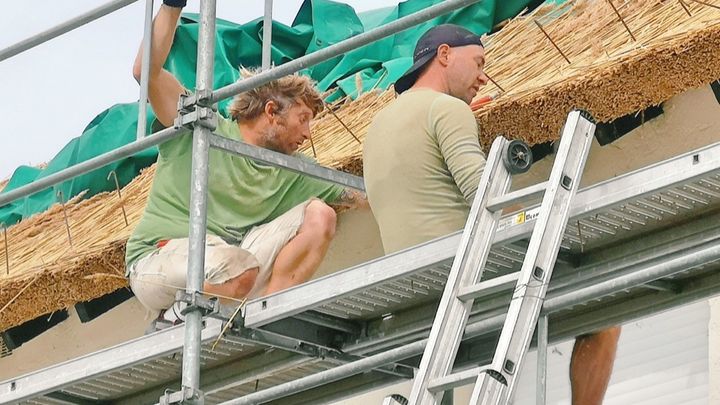
Repairing Thatch Roofs: Keeping a Tradition Alive
Two years ago, I embarked on an adventure to learn the traditional craft of roof thatching. It all got started when I wanted to repair a leak in the thatched roof of my own home in Normandy, France.
Thatch is made from long grasses, most commonly marsh reeds. This 100% natural material is cut in the late winter and dried in the open air before spring. It has a very low carbon foot print as it is already a natural carbon sink and goes through very little transformation. It has great insulating properties (30 cm is the equivalent of 10cm of fiberglass insulation) and costs the same as other materials (slate, tiles).
Despite all of these positive qualities, thatched roofs have become less common in France and seem to be limited now to historical buildings and expensive vacation homes. There are only 100 thatchers still practicing in France and there are no schools teaching the trade. Work needs to be done to communicate the potential of this age old material as a modern day solution and keep the trade alive.
But I have discovered another existential threat to the craft: the difficulty in finding a thatcher to make repairs. In my experience the preferred intervention by French thatchers when a problem arises is to just fully replace a roof with new thatch rather than repair. This is unnecessary, costs much more than a repair job and, worse, leads some home owners to abandon traditional thatch for tiles or slate.
It was not always so and there are techniques to repair, maintain and even rejuvenate a thatched roof without having to restart from scratch. But cleaning a thatched roof is labour intensive, there are challenges to integrate new thatch with old thatch for a harmonious end result and the budgets for a repair job are of course smaller. So many French thatchers do not propose repair services which can lead to people to not choose thatch for their roofs. 
So that was my dilemma two years ago when a leak sprung in my roof. None of the thatchers I contacted proposed to fix the leak. They all said to replace the whole roof.
I lamented this one night over a bottle of wine to my neighbour Luc. “Everyone has a leak in their roof around here”, he said. That did not console me. Probably fed up with my complaining Luc suggested that I fix the leak myself. Sometimes it takes just the right question to change your whole perspective. I had never considered that I could fix it myself. I had never even been up on a roof before. But maybe Luc was right. Or maybe it was the wine.
I started researching on line. Thatching turned out to be just as mysterious as I thought. As I couldn’t find anything on how to patch a leak I decided to look for someone who could show me how. I found three thatchers who mentioned apprenticeships on their websites. I wrote all three, explaining the situation of the leak in my roof and that I wanted to learn how to fix it myself. One replied, Philippe, a thatcher located in Brittany about a five hours drive from my place. He said that I had to be strong, have no fear of heights and that I could not stay at his place. Sounded good. So off I went.
I lucked out with Philippe as he was a great teacher. From the moment I got there he had me up on the roof right by his side doing what he was doing and taking all the time needed to explain the techniques. After that first internship with Philippe I knew enough to patch the leak in my roof.
But I had also discovered something else: a passion for a hand craft. I went back to do two further internships with Philippe and have now decided to become a professional thatcher myself focusing on repair and maintenance work. I lucked out studying under Philippe as he is one of the rare French thatchers that specializes in these techniques and he’s generously shared his knowledge with me. He says that the next step for me is to tackle a project on my own to apply and consolidate this knowledge. (repaired angle where the thatch had eroded)
(repaired angle where the thatch had eroded)
 (removing moss which traps humidity and causes the thatch to rot)
(removing moss which traps humidity and causes the thatch to rot) (here we are joining a section of new thatch with old thatch)
(here we are joining a section of new thatch with old thatch)
 (me learning to make junction)
(me learning to make junction)
That is what this crowd funding campaign is for: to help me purchase 2000 bundlesof natural marsh reeds to fully restore a 40 years old thatched roof (280m2). A bundle costs 2,90€ and is sold in lots of 100. So I will need 20 lots for a total budget of 5800€.
Working by myself it will take me three to four months to complete this project which Philippe says is the real test, a test of one’s skills, creativity and grit to see it through.I want to use this project to demonstrate my skills and showcase locally the economic and environmental interests in repairing and restoring an older roof rather than replacing it so that more people choose this traditional and renewable material. I also want to carefully document the process so as to be able to share it with other thatchers who may not know these techniques. In this manner I hope to contribute to the preservation and promotion of this age old craft in France.

Thank you for reading my story. I am very grateful for all of the knowledge and experience that has already been made available to me. Please share with anyone you think who could be interested.